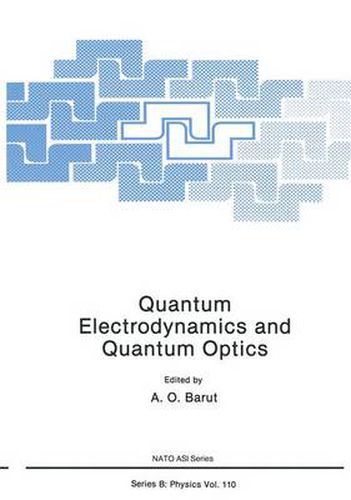Readings Newsletter
Become a Readings Member to make your shopping experience even easier.
Sign in or sign up for free!
You’re not far away from qualifying for FREE standard shipping within Australia
You’ve qualified for FREE standard shipping within Australia
The cart is loading…






This title is printed to order. This book may have been self-published. If so, we cannot guarantee the quality of the content. In the main most books will have gone through the editing process however some may not. We therefore suggest that you be aware of this before ordering this book. If in doubt check either the author or publisher’s details as we are unable to accept any returns unless they are faulty. Please contact us if you have any questions.
The borderline of quantum electrodynamics and quantum optics offer spectacular results and problems concerning the foundations of radiation theory. Perhaps the major new viewpoint that has emerged from recent investigations is that one can now work inside a time-dependent quantum process, whereas up to now all elementary quantum processes were either stationary, or one worked with asymptotic in-and out-states, i.e. an S-matrix approach. In the-rirst part of this volume, the Quantum Electrodynamics, the present status of the main approaches to this most accurate of all physical theories are discussed: the Hamiltonian approach, the Green’s function approach with particular emphasis to bound state problems, and the newer, nonperturbative approach. The latest numerical results on radiative corrections, Lamb shifts and anomalous magnetic moments are reviewed with new results for high Z atoms. Also discussed are different theoretical interpretations of the radiative phenomena as due to quantized field vacuum fluctuations or due to self energy. A small group of contributions are devoted to the physics and mathematical description of decaying or unstable states in quantum theory. This remarkable phenomenon of quantum theory still needs complete clarification, it is a time-dependent phenomenon, which can be described also by asymptotic S-matrix methods, but with complex energies.
$9.00 standard shipping within Australia
FREE standard shipping within Australia for orders over $100.00
Express & International shipping calculated at checkout
This title is printed to order. This book may have been self-published. If so, we cannot guarantee the quality of the content. In the main most books will have gone through the editing process however some may not. We therefore suggest that you be aware of this before ordering this book. If in doubt check either the author or publisher’s details as we are unable to accept any returns unless they are faulty. Please contact us if you have any questions.
The borderline of quantum electrodynamics and quantum optics offer spectacular results and problems concerning the foundations of radiation theory. Perhaps the major new viewpoint that has emerged from recent investigations is that one can now work inside a time-dependent quantum process, whereas up to now all elementary quantum processes were either stationary, or one worked with asymptotic in-and out-states, i.e. an S-matrix approach. In the-rirst part of this volume, the Quantum Electrodynamics, the present status of the main approaches to this most accurate of all physical theories are discussed: the Hamiltonian approach, the Green’s function approach with particular emphasis to bound state problems, and the newer, nonperturbative approach. The latest numerical results on radiative corrections, Lamb shifts and anomalous magnetic moments are reviewed with new results for high Z atoms. Also discussed are different theoretical interpretations of the radiative phenomena as due to quantized field vacuum fluctuations or due to self energy. A small group of contributions are devoted to the physics and mathematical description of decaying or unstable states in quantum theory. This remarkable phenomenon of quantum theory still needs complete clarification, it is a time-dependent phenomenon, which can be described also by asymptotic S-matrix methods, but with complex energies.